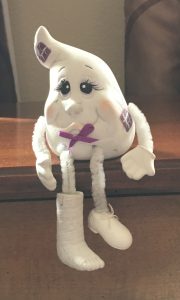First workday in the National Health Services Corp
It’s July 5, 1982. We arrived on July 3 and, obviously, July 4 was a holiday. Yesterday we were invited to a small cookout where we met some local residents who were very nice and who told me that my physician counterpart at the clinic was on vacation that week, meaning, I was on my own. For the week. Me a physician just graduating from the somewhat sheltered life of academic medicine with no transitional mentor. Not that it mattered much, it turned out. My physician counterpart, Dr. Jones, had only completed a one year rotating internship and was planning on going into Orthopedics and had one more of his two year National Health Service Corps stint to complete. His knowledge base was fairly restricted in breadth and depth, it turned out. I was Board eligible in Internal Medicine and had been in one of the first “Primary Care Tracks” ever offered by the Internal Medicine Society, so I had done OB, Pediatrics, NICU, Orthopedics, and Outpatient GYN in addition to the array of Adult Medicine services for three years.
I was now an LMD (Local Medical Doctor) LMD’s were routinely derided where I trained (and every other academic medical center, I learned from talking with other physicians my same age).
I was told clinic hours started at 0800h, so, I arrived at the clinic at about 0745h. I met the staff, Mary, LPN, Linda, LPN and Joan, the receptionist. Janie, the clinic manager, who also managed two other clinics, wasn’t there. Mary showed me where everything was, what I was supposed to do with the encounter sheet, and said, “We have a full schedule today, 24 patients. Dr. Jones has never seen that many in a day!” I said, “I guess we’ll have to put our roller skates on!” I’d never seen more than a half dozen patients in a session of “General Medicine Clinic” while in training at Dartmouth-Hitchcock Medical Center.
The clinic had been taken over by a Community Health Care System from a Dr. Rogers. Dr. Rogers was used to seeing over 40 patients a day. Dr. Rogers turned out to be an impaired physician and was currently working for a blood bank in the Twin Cities, but he still lived in our town. He would stop by the hospital on his way home to see what was going on and he would often sneak into the OR area and sniff nitrous oxide. After reviewing his medical records, it was obvious that he wasn’t very thorough, with lots of chronic illnesses being uncontrolled.
I started seeing patients at 0800h. Blood pressure checks, a sprain, a Pap smear, a well child check, etc. Halfway into the morning, I got a call from the hospital. They wanted to know if I was going to round on the inpatients. No one had told me I was supposed to do that. There were 3 patients in the house. I told them I would see them during lunch. My next patient came in for a blood pressure check. He was on SerApEs, Dr. Roger’s go-to BP med. While I was examining him, I noticed he was having runs of tachycardia. He also wanted me to check out a growth on his chest wall. The “growth” was a quarter inch irregular subcutaneous nodule that was rock hard. We did an ECG and he was having runs of ventricular tachycardia (V-Tach). I immediately had him ushered over to the hospital (which was only an alley way from the clinic back door). They had just installed a 2 bed “ICU” at the hospital across from the (only) nursing station. I had them put him on the monitor and checked a battery of tests. It turned out his potassium was below 2.0, likely due to the diuretic in SerApEs. I ordered runs of IV potassium.
I finished up my morning patients and went over to the hospital. The cardiac monitoring main-station was on the counter top of the main (only) nurse’s station. The hospital was a 20 bed one story hospital with a small OR area and one delivery room with a one bed labor room. I checked on the patient I admitted and rounded on the other three patients, who were divided between Dr. Jones and a long-time local physician who was in a clinic about 20 miles away in the next city, Dr. Brown, who I had never met. Everyone was stable so I ate a quick lunch from the hospital kitchen and went back to the clinic for the afternoon.
About an hour into my first afternoon session, I got a frantic call from the hospital. A woman with two children had shown up at the hospital in labor. She was a single mom who had just moved up from the Twin Cites. I ran over to the hospital. I had never delivered a baby alone, having been in two rather large community hospitals with a dozen nurses and back-up OB/GYNs. Now it was just one nurse and I. The nurse showed me around the delivery room, where all the equipment was, how thing usually were done there. They had one new delivery room bassinet for evaluating newborns. The only suction device was a DeLee suction (you use your mouth to suck mucous from baby mouths and noses). There was no fetal monitoring device. A nurse had to use a hand held fetal Doppler and record what she heard in the paper chart.
I went to the labor room, met the mother in labor and started to describe the plan of care when she got up and started to get dressed and said she would be leaving to go to the Twin Cities. I had checked her cervix and she was just about in transition. I told her she likely wouldn’t make it to Minneapolis/St Paul. She called her sister who lived in our towm, signed out AMA and left with her sister. We were 98 miles from St Paul.
I left for clinic and saw the rest of my patients. Mary was impressed that I had seen the 24 patients plus all of the goings on of the day.
I went back over to the hospital. I saw my ICU patient. He still needed more potassium. He had no evidence for a heart attack, so this was mainly a metabolic problem. As I was writing my note on the patient, he had a 10-12 beat run of V-Tach. I asked the nurse to hit the button to get a strip so I could put it in the chart. But, by the time she hit the button, the V-Tach was gone and the strip was normal. This perplexed me because all of the monitoring stations I have been exposed to in training had a 10-15 second memory. The nurse said the one they were renting had no memory. This meant it was only possible to document a dysrhythmia if it lasted long enough for someone to notice and hit the button fast enough.
I asked the nurse if she knew what the rhythm was. She got up and walked over to a chart with rhythm examples that was tacked up on the wall. She scanned the chart and picked a rhythm that she thought matched the rhythm. “It looks like ventricular tachycardia”, she said. I asked. “What do you do if that rhythm doesn’t stop?” She said, “I call you.” I said, “I know you call me but what do you do while waiting for me?” She said, “ We just call you.” I asked, “Haven’t you had training on how to respond to things like this while waiting for me to arrive? I don’t have a phone yet, I’m only going to have the pager and I live two blocks from here. I won’t know why you paged me and I can’t give you phone orders.” She said, “The administration has decided they don’t have the money to train us. Another hospital (35 miles away) started an ICU and they trained the nurses, but we aren’t getting that.”
I sat there for about 45 minutes writing out protocols for the various scenarios the patient might get into during the night and went over them with the nurse. At night, there was only an LPN or an RN and a nurse’s aide in the hospital. Luckily, the patient made it through the night without incident and he had a normal potassium by the morning. We watched him one more day, through which he had no more runs of V-Tach and was discharged. Unfortunately, his chest X-ray had a mass in his lung, and the excisional biopsy of the chest lesion was metastatic squamous cell lung cancer.
The next day, right after rounding on the inpatients, I went to the administrator’s office. The administrator, Harry, was at his desk. I explained to him that the rented monitor station had to be replaced with one with memory and that the nurses required training. He said they would look into changing out the monitoring station but, there was no money for nurse training. I said, “You can’t have an ICU and not have trained nursing staff”. He said, “We’re not shutting down the ICU, it’s a money maker for us. We need the revenue. You’ll just have to make do.” I said, “You’re putting people’s lives in danger. If you don’t train the nurses you either have to shut down the ICU or I’ll transfer all ICU patients to Duluth (76 miles away).” He said, “ We’ll be informing the staff to ignore your transfer orders. We are not shutting down the ICU. We need the patients here and in our ICU.”
This is the moment when I realized that health/hospital systems do not primarily have the best interests of patients in mind. Money came first. It was a hard lesson to learn so soon out of training. Health systems are “for” patients and “quality care” as long as there is a positive margin/profit involved. Otherwise, the decision favors the bottom line.
I had our nurses query the other hospital with the ICU’s nurses to find out how they were trained and what materials they used. I had the nurses purchase the textbook, I purchased the instructor materials and text book, including ECG and ECG strip slides and spent the next six months every Wednesday night training the nurses in Cardiac Critical Care.
The nurses truly cared about the patients. The hospital, not so much.
As far as the mother in labor, she went through transition about half way to St Paul. Her sister noticed a state trooper who had stopped a car on the other side of the interstate. She stopped the car, ran across the interstate and told the trooper they were just about to have a baby. He crossed the interstate median, and, with siren blaring and calling ahead to Ramsey County Medical center, drove 90 miles an hour down the interstate with the mother in labor following. Luckily, the interstate off-ramp to the Medical Center just about ended at the ER entrance. The ER staff barely got the patient into the ER when the she gave birth. Mother and baby did just fine. The woman came back to our town and I was her and her children’s primary care physician. We always laughed about our first meeting and the day’s events.

